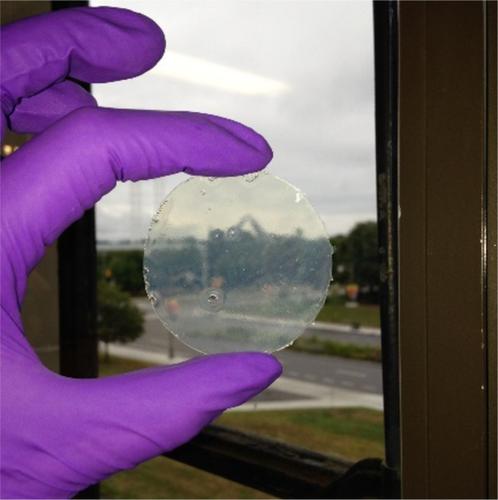当前位置:
X-MOL 学术
›
J. Polym. Sci.
›
论文详情
Our official English website, www.x-mol.net, welcomes your
feedback! (Note: you will need to create a separate account there.)
Noncovalent functionalization of boron nitride nanotubes using poly(2,7‐carbazole)s
Journal of Polymer Science ( IF 3.9 ) Pub Date : 2020-06-12 , DOI: 10.1002/pol.20200164 Nicole A. Rice 1 , William J. Bodnaryk 1 , Isaac Tamblyn 2 , Zygmunt J. Jakubek 3 , Jacques Lefebvre 2 , Greg Lopinski 3 , Alex Adronov 1 , Christa M. Homenick 2
Journal of Polymer Science ( IF 3.9 ) Pub Date : 2020-06-12 , DOI: 10.1002/pol.20200164 Nicole A. Rice 1 , William J. Bodnaryk 1 , Isaac Tamblyn 2 , Zygmunt J. Jakubek 3 , Jacques Lefebvre 2 , Greg Lopinski 3 , Alex Adronov 1 , Christa M. Homenick 2
Affiliation

|
To fully actualize the potential of boron nitride nanotubes (BNNTs), it is necessary to overcome the inherent insolubility of this nanomaterial. Drawing on the successes realized in the analogous carbon nanotube field, noncovalent functionalization with conjugated polymers offers a simple, scalable route toward the production of stable dispersions of BNNTs. 2,7‐carbazoles were chosen as our core monomer based on density functional theory (DFT) predictions, which suggest superior interactions with BNNTs when compared to fluorene‐BNNT interactions. Homo poly(2,7‐carbazole)s and copolymers with fluorenes were synthesized and used successfully to disperse BNNTs into organic solvents. Thermogravimetric analysis and atomic force microscopy results confirm the proficiency of these polymers to disperse large amounts (> 80% by weight) of individualized BNNTs. Analysis of absorbance data shows that the choice of solvent is critical, with stability enhanced in THF compared to CHCl3 due to the more efficient planarization of polymer chains on the surface of BNNTs, particularly for the homopolymers. The utility of these highly‐soluble poly(2,7‐carbazole)‐BNNT complexes for printed electronics and transparent composites was demonstrated by the fabrication of simple capacitors and incorporation into poly(methyl methacrylate) composites, respectively.
中文翻译:

使用聚(2,7-咔唑)s对氮化硼纳米管进行非共价官能化
为了充分实现氮化硼纳米管(BNNT)的潜力,有必要克服这种纳米材料固有的不溶性。利用在类似的碳纳米管领域取得的成功,共轭聚合物的非共价官能化为生产稳定的BNNT分散体提供了一种简单,可扩展的途径。根据密度泛函理论(DFT)的预测,选择2,7-咔唑作为我们的核心单体,这表明与芴-BNNT相互作用相比,与BNNT的相互作用更好。合成了聚(2,7-咔唑)均聚物和与芴的共聚物,并将其成功地用于将BNNT分散到有机溶剂中。热重分析和原子力显微镜结果证实了这些聚合物能够大量分散(> 80%(重量)的个性化BNNT。吸光度数据分析表明溶剂的选择至关重要,与CHCl相比,在THF中的稳定性增强3由于硼氮纳米管的表面上的聚合物链,特别是用于均聚物的更有效的平坦化。这些高溶解度的聚(2,7-咔唑)-BNNT复合物在印刷电子产品和透明复合材料中的实用性已通过简单电容器的制造并结合到聚甲基丙烯酸甲酯复合物中得到了证明。
更新日期:2020-06-12
中文翻译:

使用聚(2,7-咔唑)s对氮化硼纳米管进行非共价官能化
为了充分实现氮化硼纳米管(BNNT)的潜力,有必要克服这种纳米材料固有的不溶性。利用在类似的碳纳米管领域取得的成功,共轭聚合物的非共价官能化为生产稳定的BNNT分散体提供了一种简单,可扩展的途径。根据密度泛函理论(DFT)的预测,选择2,7-咔唑作为我们的核心单体,这表明与芴-BNNT相互作用相比,与BNNT的相互作用更好。合成了聚(2,7-咔唑)均聚物和与芴的共聚物,并将其成功地用于将BNNT分散到有机溶剂中。热重分析和原子力显微镜结果证实了这些聚合物能够大量分散(> 80%(重量)的个性化BNNT。吸光度数据分析表明溶剂的选择至关重要,与CHCl相比,在THF中的稳定性增强3由于硼氮纳米管的表面上的聚合物链,特别是用于均聚物的更有效的平坦化。这些高溶解度的聚(2,7-咔唑)-BNNT复合物在印刷电子产品和透明复合材料中的实用性已通过简单电容器的制造并结合到聚甲基丙烯酸甲酯复合物中得到了证明。









































 京公网安备 11010802027423号
京公网安备 11010802027423号